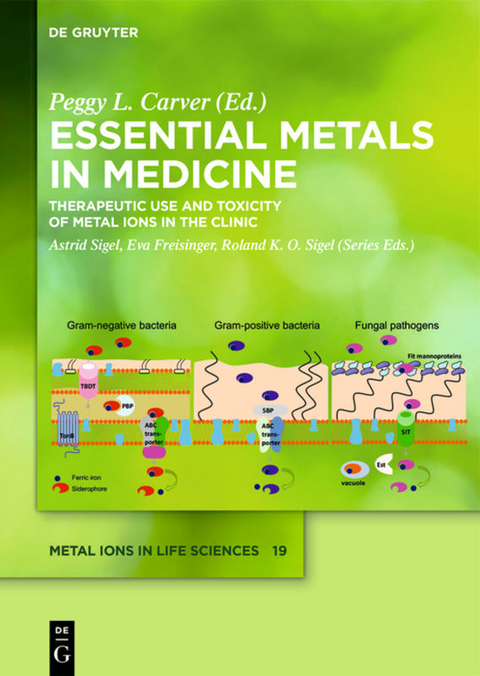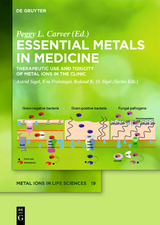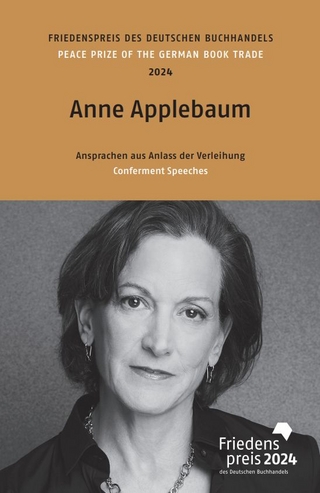Essential Metals in Medicine: Therapeutic Use and Toxicity of Metal Ions in the Clinic
De Gruyter (Verlag)
978-3-11-052691-2 (ISBN)
Volume 19, entitled Essential Metals in Medicine: Therapeutic Use and Toxicity of Metal Ions in the Clinic of the series Metal Ions in Life Sciences centers on the role of metal ions in clinical medicine. Metal ions are tightly regulated in human health: while essential to life, they can be toxic as well. Following an introductory chapter briefly discussing several important metal-related drugs and diseases and a chapter about drug development, the focus is fi rst on iron: its essentiality for pathogens and humans as well as its toxicity. Chelation therapy is addressed in the context of thalassemia, its relationship to neurodegenerative diseases and also the risks connected with iron administration are pointed out. A subject of intense debate is the essentiality of chromium and vanadium. For example, chromium(III) compounds are taken as a nutritional supplement by athletes and bodybuilders; in contrast, chromate, Cr(VI), is toxic and a carcinogen for humans. The benefi cial and toxic effects of manganese, cobalt, and copper on humans are discussed. The need for antiparasitic agents is emphasized as well as the clinical aspects of metal-containing antidotes for cyanide poisoning. In addition to the essential and possibly essential ones, also other metal ions play important roles in human health, causing harm (like the metalloid arsenic, lead or cadmium) or being used in diagnosis or treatment of human diseases, like gadolinium, gallium, lithium, gold, silver or platinum. The impact of this vibrant research area on metals in the clinic is provided in 14 stimulating chapters, written by internationally recognized experts from the Americas, Europe and China, and is manifested by approximately 2000 references, and about 90 illustrations and tables. Essential Metals in Medicine: Therapeutic Use and Toxicity of Metal Ions in the Clinic is an essential resource for scientists working in the wide range from pharmacology, enzymology, material sciences, analytical, organic, and inorganic biochemistry all the way through to medicine ... not forgetting that it also provides excellent information for teaching.
Peggy L. Carver, College of Pharmacy, University of Michigan, Ann Arbor, USA.
"In conclusion, this volume of MILS lives up in every way to the high standard set by previous volumes. I recommend it as strongly as possible not only to those individuals or institutions with a regular subscription to the series, but also to any researcher with an interest in the medical/medicinal/health (however one might distinguish amongst these areas) aspects of metal ions. Thus, both clinical and basic researchers would benefit greatly from volume 19 of MILS."
Joshua Telser in: Coordination Chemistry Reviews 392 (2019), 81-82
"Overall, this volume is a nice compilation of articles describing some of the emerging therapeutic uses of metals in medicine. Each chapter has an extensive literature survey which would be of benefit to the researchers in their areas. It would also serve as an excellent introduction to readers interested in metals in medicine and their possible therapeutic benefits."
Bibudhendra Sarkar in: Journal of Inorganic Biochemistry 199 (2019), DOI https://doi.org/10.1016/j.jinorgbio.2019.110794
| Erscheinungsdatum | 15.01.2019 |
|---|---|
| Reihe/Serie | Metal Ions in Life Sciences ; 19 |
| Co-Autor | Bernard Meunier, Anne Robert, Guido Crisponi, Valeria Nurchi, Joanna I. Lachowicz, Manfred Nairz, Guenter Weiss, Amy B. Pai, Roberta J. Ward, Robert R. Crichton, Keith M. Erikson, Michael Aschner, Jay Lopez, Divya Ramchandani, Linda T. Vahdat, Debbie C. Crans, Barry I. Posner, Aviva Levina, Peter A. Lay, Elizabeth A. Bajema, Kaleigh Roberts, Thomas J. Meade, Dinorah Gambino, Lucía Otero, Elzbieta Gumienna-Kontecka, Sigrídur G. Suman, Johanna M. Gretarsdottir |
| Zusatzinfo | 150 col. ill., 100 b/w tbl. |
| Verlagsort | Berlin/Boston |
| Sprache | englisch |
| Maße | 170 x 240 mm |
| Gewicht | 974 g |
| Themenwelt | Naturwissenschaften ► Chemie |
| Sozialwissenschaften ► Kommunikation / Medien ► Buchhandel / Bibliothekswesen | |
| Schlagworte | Anorganische Chemie • Arzneimitteldesign • Bioanorganische Chemie • Koordinationschemie |
| ISBN-10 | 3-11-052691-3 / 3110526913 |
| ISBN-13 | 978-3-11-052691-2 / 9783110526912 |
| Zustand | Neuware |
| Informationen gemäß Produktsicherheitsverordnung (GPSR) | |
| Haben Sie eine Frage zum Produkt? |
aus dem Bereich




